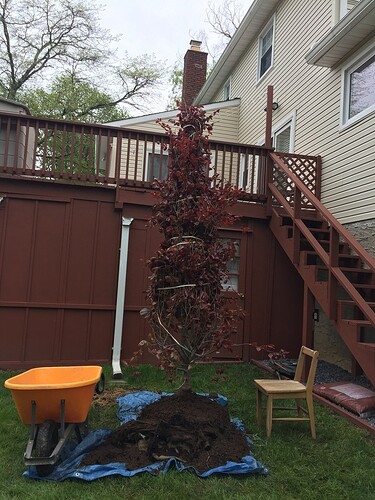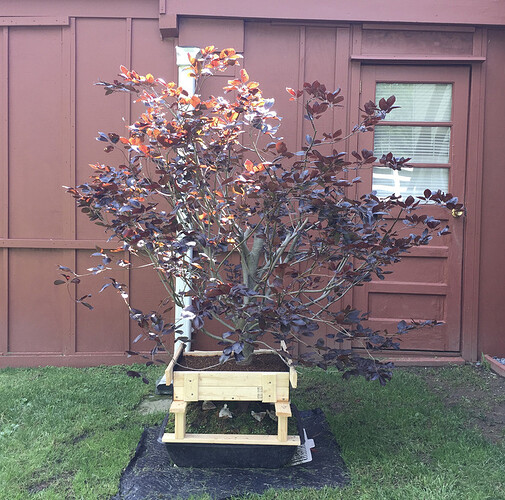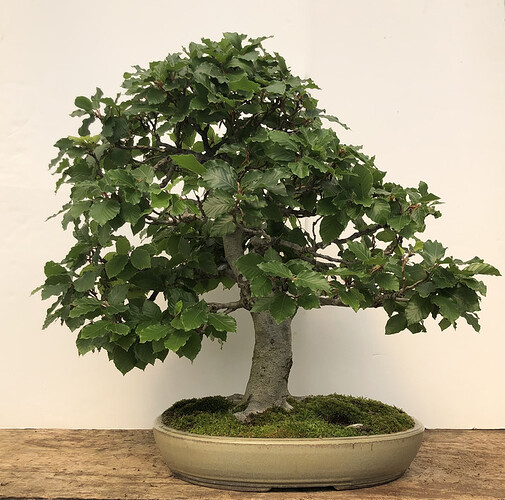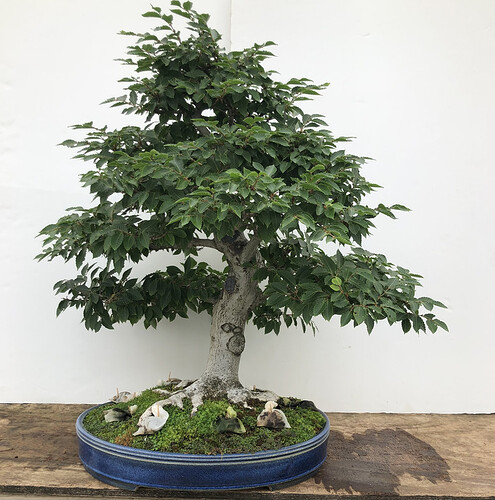I’ve always been on the lookout for purple beech that would make acceptable bonsai, but because of the almost-always ugly graft unions on the decent-sized cultivars you find at nurseries, and the difficulty of successfully air-layering them above the grafts (at least for me), it’s an almost impossible endeavor. Anyway, and in spite of past failures, in the Spring of 2019 I came across a few large ball-and-burlapped Fagus Sylvatica Spaethiana at a local nursery, and finding one with low branching that interested me, I decided to give it another shot. These particular beeches leaf out a week later and have a slightly smaller leaf than the species; they also retain their rich purple color much longer than any other beech. Of course, working on a B&B tree is labor intensive, to say the least. After uncovering the usual ugly graft and getting down to the surface roots, I reduced the rootball to an acceptable level and planted it in a plastic cement mixing tray (which I punched full of holes), and also trimmed the branches back some (pic #4.) The process to a solid 8 hours, so if you ever try this and want to finish in one day, you better start early in the morning! After a six-week period had passed, the air-layer was begun directly above the graft. I built a wooden box with 2 of its sides and the bottom made of doubled plastic drainage mesh, suspending and stabilizing the box in the proper position (pic #5.) 3 days later (pic #6), I got a little creative and reduced the branches again (this might’ve been the wrong thing to do, but what the heck, it survived, and even budded back some!) In March 2020, I checked the air-layer and discovered no noticeable roots, so I re-scored the now-formed callous, and using Ryan’s tutorial, root-grafted 4 seedlings just a tiny bit above the graft-line. In late Spring 2020, I treated the tree as if it were in bonsai training and performed a partial defoliation (again, probably pushing it, but I’m not getting any younger.) Pic #7 (the last photo with the wooden box) was taken in Oct. 2020 with the seedlings still attached. In March 2021, I discovered 2 lines of air-layered roots, plus at least 2 of the root grafts quite solidly fused, so the tree was finally separated. The last 2 photos show the separated tree; it may not look like much now, but moving forward I think it has possibilities. And I accomplished what I was trying to accomplish.
(Ooops!) Edit: The 4 seedlings were thread-grafted slightly above the air-layer line; I mistakenly wrote the graft-line.
wow, lots of technique and work gone into this one, well done! I absolutely love purple beech.
Looks like this tree is going to reward your effort and bravery, good luck!
Thx. the trickiest part was stabilizing the separated tree in the Anderson flat. Wish there was an easier way to find an ungrafted purple beech with bonsai potential, with a 3.5" trunk.
Any update on this tree?
I know it’s old thread but I had to commend the effort, executive and craftsmanship throughout the pursuit! I am also going to have to steal the cement tray with wood scaffolding airlayer pot setup!
Thanks for the kind words! Well it’s been been an ongoing procedure. Some ups, some downs. I probably pushed it a little too much in the summer of 2021, as I trimmed back to usable branches, and the tree did not respond well, so it definitely slowed down its development (beech move in slow-motion as it is, so it was disappointing.) I did figure I would post a photo if it ever started to look like an actual bonsai, but since you asked, here’s an update. I decided to get it out of the Anderson flat this spring, and put it into whatever pot I had that functioned the best at this particular time (obviously I don’t want to root-prune.) I built a greenhouse over the winter, and I left the tree in there since its repot, and it has reacted quite favorably to the humid conditions. As much as I hated removing the central leader during the initial work, I do have a design idea for its future.
Thanks for the updates and I am impressed with where you got it to date. You have spent the time setting up the whole infrastructure of what will be an amazing tree and species’s/cultivar you couldn’t find but made 100% from scratch…it’s commendable and I appreciate you letting me (as a newer member )peak brhind the timeline vail and see tree making execution by someone more mortal than Ryan
If you have any Fagus specific nuance’s, advice or knowledge you could share I would greatly appreciate it!
As I’ve just trimmed them, here are some before-and-after pics of 2 beech I’ve had for awhile. One is European and the one in the blue pot is Japanese. They weren’t much when I bought them, particularly the European beech, which was just a stump taken out of the field. I did a little leaf reduction on the Japanese beech, but don’t know if I want to do any more (on either) this year. Ryan’s leaf reduction/partial defoliation method is the way to go, if you want a (sort-of) second flush. I would never remove all the leaves entirely, as per Walter Pall. I live in New Jersey, zone 7, so I like to put my trees in a low-light shed, from about mid-November on, till sometime in the spring. The new greenhouse helps enormously with transitioning them from the shed into spring. Hmmm, any tips I would have is that you should remove the dead leaves in winter sooner than later, because next year’s buds get very fragile when they ripen in the early spring and it’s easy to damage/knock them off if you take the dead leaves off that late. Wiring is very easy and fun on beech but that doesn’t mean a branch won’t struggle to leaf out anyway, so I sometimes wait till they leaf out a bit before messing around with branch placement. Also, using organic fertilizer (I like biogold in the tea bags) has a tremendous effect on keeping them healthy and vigorous. I’ve been using 100% akadama for the last 5 years or so, and they seem to be doing well in it, but I can’t really gauge how much difference there would be if I were to use a mix. Also, IMO, root reduction should be done much more cautiously than, say, a Japanese maple. Actually, the worst thing that happened to my trees was having to move, which I’ve done twice in the last ten years, and setting up a new environment for them.














